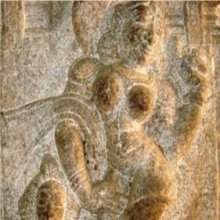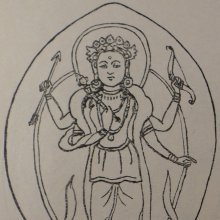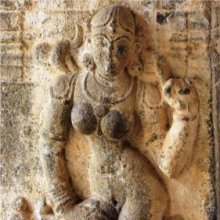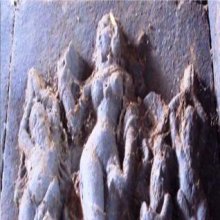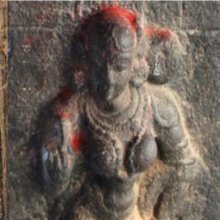Tarjani, Tarjanī: 12 definitions
Introduction:
Tarjani means something in Buddhism, Pali, Hinduism, Sanskrit, Marathi, Hindi. If you want to know the exact meaning, history, etymology or English translation of this term then check out the descriptions on this page. Add your comment or reference to a book if you want to contribute to this summary article.
Images (photo gallery)
(+24 more images available)
In Hinduism
Shilpashastra (iconography)
Source: Shodhganga: The significance of the mūla-beras (śilpa)Tarjanī (तर्जनी) or Tarjanīhasta refers to “underline, warn” and represents one of the twenty-four gestures with a single hand, as defined according to texts dealing with śilpa (arts and crafs), known as śilpaśāstras.—Accordingly, pratimā-lakṣaṇa (body postures of the icons) is comprised of hand gestures (hasta, mudrā or kai-amaiti), stances/poses (āsanas) and inflexions of the body (bhaṅgas). There are thirty-two types of hands [viz., tarjanī-hasta] classified into two major groups known as tolirkai (functional and expressive gestures) and elirkai (graceful posture of the hand).

Shilpashastra (शिल्पशास्त्र, śilpaśāstra) represents the ancient Indian science (shastra) of creative arts (shilpa) such as sculpture, iconography and painting. Closely related to Vastushastra (architecture), they often share the same literature.
Ayurveda (science of life)
Source: gurumukhi.ru: Ayurveda glossary of termsTarjanī (तर्जनी):—Index finger. Second digit

Āyurveda (आयुर्वेद, ayurveda) is a branch of Indian science dealing with medicine, herbalism, taxology, anatomy, surgery, alchemy and related topics. Traditional practice of Āyurveda in ancient India dates back to at least the first millenium BC. Literature is commonly written in Sanskrit using various poetic metres.
Shaktism (Shakta philosophy)
Source: Google Books: ManthanabhairavatantramTarjanī (तर्जनी) refers to the “index finger”, according to the Śrīmatottara-tantra, an expansion of the Kubjikāmatatantra: the earliest popular and most authoritative Tantra of the Kubjikā cult.—Accordingly, [while describing the visualized form of Navātman Bhairava]: “[...] Navātman’s mind is blissful with his own energy and he is delighted by the bliss of (spiritual) wine. [...] He has eighteen arms and is adorned with many ornaments. A skull, conch, noose, gaud, (a threatening gesture with the) index finger (tarjanī), bow, shield and a club studded with iron are on the left hand side. O dear one, a trident, double-headed drum, sword, ascetic’s staff, pestle, bell, thread, arrow and boon-bestowing gesture are on the right”.

Shakta (शाक्त, śākta) or Shaktism (śāktism) represents a tradition of Hinduism where the Goddess (Devi) is revered and worshipped. Shakta literature includes a range of scriptures, including various Agamas and Tantras, although its roots may be traced back to the Vedas.
In Buddhism
Tibetan Buddhism (Vajrayana or tantric Buddhism)
Source: Wisdom Library: Tibetan Buddhism1) Tarjanī (तर्जनी) is the name of Dūtī (i.e., messengers of Lord Vajrapāṇi) mentioned as attending the teachings in the 6th century Mañjuśrīmūlakalpa: one of the largest Kriyā Tantras devoted to Mañjuśrī (the Bodhisattva of wisdom) representing an encyclopedia of knowledge primarily concerned with ritualistic elements in Buddhism. The teachings in this text originate from Mañjuśrī and were taught to and by Buddha Śākyamuni in the presence of a large audience (including Tarjanī).
2) Tarjanī (तर्जनी) is also the name of a Piśācī mentioned as attending the teachings in the 6th century Mañjuśrīmūlakalpa.
Source: academia.edu: The Structure and Meanings of the Heruka MaṇḍalaTarjanī (तर्जनी) refers to a “threatening hand posture” and represents one of the gestures made with the left hand of Heruka: one of the main deities of the Herukamaṇḍala described in the 10th century Ḍākārṇava chapter 15. Heruka is positioned in the Lotus (padma) at the center; He is the origin of all heroes; He has 17 faces (with three eyes on each) and 76 arms [exhibiting, for example, tarjanī]; He is half black and half green in color; He is dancing on a flaming sun placed on Bhairava and Kālarātrī.
Source: OSU Press: Cakrasamvara SamadhiTarjanī (तर्जनी) refers to a “threatening finger” (pointing in the direction of all defilement), according to the Cakrasaṃvara Samādhi [i.e., Cakrasamvara Meditation] ritual often performed in combination with the Cakrasaṃvara Samādhi, which refers to the primary pūjā and sādhanā practice of Newah Mahāyāna-Vajrayāna Buddhists in Nepal.—Accordingly, “[...] Six joyful seals, the foremost of them (being) her holiness, Colored red, with one face, two arms, and three eyes, Naked with loose hair, (and) partly adorned with a girdle, The left arm embracing, holding in a skull bowl, sin and death for eating, On the right a threatening finger (tarjanī) pointing in the direction of all defilement, Sounding the thunder of an impending kalpa-fire of great majesty, With the bloody opening (between) both hips penetrated by (her) hero, One who loves great pleasure, belonging to the nature of compassion”.

Tibetan Buddhism includes schools such as Nyingma, Kadampa, Kagyu and Gelug. Their primary canon of literature is divided in two broad categories: The Kangyur, which consists of Buddha’s words, and the Tengyur, which includes commentaries from various sources. Esotericism and tantra techniques (vajrayāna) are collected indepently.
Languages of India and abroad
Marathi-English dictionary
Source: DDSA: The Molesworth Marathi and English Dictionarytarjanī (तर्जनी).—f S The fore-finger, the index.
Source: DDSA: The Aryabhusan school dictionary, Marathi-Englishtarjanī (तर्जनी).—f The fore-finger. The index.
Marathi is an Indo-European language having over 70 million native speakers people in (predominantly) Maharashtra India. Marathi, like many other Indo-Aryan languages, evolved from early forms of Prakrit, which itself is a subset of Sanskrit, one of the most ancient languages of the world.
Sanskrit dictionary
Source: Cologne Digital Sanskrit Dictionaries: Monier-Williams Sanskrit-English Dictionary1) Tarjanī (तर्जनी):—[from tarjana > tarj] f. ‘threatening finger’, the fore-finger, [Kathāsaritsāgara xvii, 88; Kātyāyana-śrauta-sūtra [Scholiast or Commentator]]
2) [v.s. ...] = nikā, [Hemādri’s Caturvarga-cintāmaṇi ii, 1.]
Source: DDSA: Paia-sadda-mahannavo; a comprehensive Prakrit Hindi dictionary (S)Tarjanī (तर्जनी) in the Sanskrit language is related to the Prakrit word: Tajjaṇī.
Sanskrit, also spelled संस्कृतम् (saṃskṛtam), is an ancient language of India commonly seen as the grandmother of the Indo-European language family (even English!). Closely allied with Prakrit and Pali, Sanskrit is more exhaustive in both grammar and terms and has the most extensive collection of literature in the world, greatly surpassing its sister-languages Greek and Latin.
Hindi dictionary
Source: DDSA: A practical Hindi-English dictionaryTarjanī (तर्जनी):—(nf) the fore-finger, trigger-finger.
...
Kannada-English dictionary
Source: Alar: Kannada-English corpusTarjani (ತರ್ಜನಿ):—[noun] the finger nearest the thumb (used to point something or someone at); the forefinger; the index finger.
Kannada is a Dravidian language (as opposed to the Indo-European language family) mainly spoken in the southwestern region of India.
See also (Relevant definitions)
Starts with: Tarjani Mudra, Tarjanihasta, Tarjanika, Tarjaniya.
Ends with: Udamcitatarjani.
Full-text (+52): Tarjani Mudra, Tajjani, Ankushamudra, Tarccani, Galini, Tarcani, Tarjanihasta, Tarjana, Needle, Stitching, Aparajita, Jayanta, Sureshvara, Hara, Revata, Virupaksha, Tryambaka, Aja, Bahurupa, Ekapada.
Relevant text
Search found 12 books and stories containing Tarjani, Tarjanī; (plurals include: Tarjanis, Tarjanīs). You can also click to the full overview containing English textual excerpts. Below are direct links for the most relevant articles:
Stupas in Orissa (Study) (by Meenakshi Chauley)
Emanations of Vairocana < [Chapter 5]
Emanations of Amoghasiddhi < [Chapter 5]
Drum slabs at at Ratnagiri < [Chapter 4]
The Agni Purana (by N. Gangadharan)
The Indian Buddhist Iconography (by Benoytosh Bhattachacharyya)
Figure 208 - Four Dance Deities: Nṛtyā
Figure 206 - Four Dance Deities: Lāsyā
Varahi Tantra (English Study) (by Roberta Pamio)
Chapter 29 - The worship of Caṇḍikā < [Summary of the Vārāhī Tantra]
Chapter 22 - The the Six Āmnāyas < [Summary of the Vārāhī Tantra]
The Garuda Purana (by Manmatha Nath Dutt)
Chapter XXVI - The mode of performing the rites of Karanyasa < [Agastya Samhita]
Chapter CXXXIII - Asokastami Vratas etc < [Brihaspati (Nitisara) Samhita]
Temples of Munnur (Historical Study) (by R. Muthuraman)
Images of Dvarapalas < [Chapter 5]

